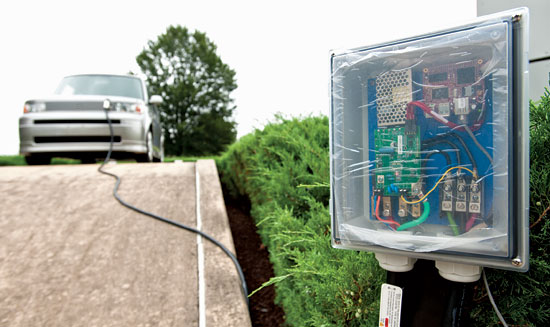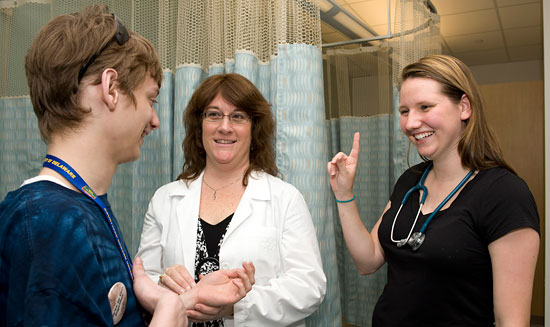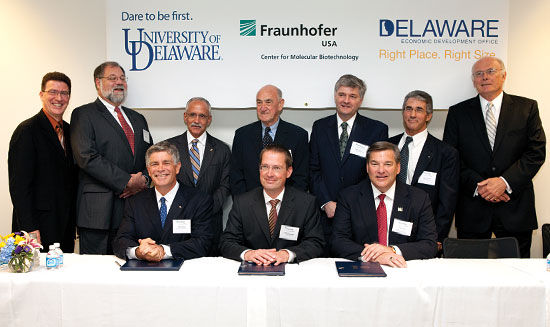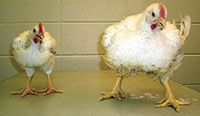

Vice President Joseph R. Biden Jr., a U.S. senator from Delaware for 36 years until his election as vice president in 2008, and a 1965 graduate of the University of Delaware, was on campus Sept. 16 to donate his senatorial papers to the University Library and to deliver the inaugural James R. Soles Lecture on the Constitution and Citizenship. The lecture, to be given annually in celebration of national Constitution Day, is named in honor of the late Alumni Distinguished Professor Emeritus Jim Soles.
The vice president's senatorial papers — a collection that also includes records in various formats such as recordings and web pages — will be processed, preserved and housed in the UD Library's Special Collections Department, where staff members are nationally known for their expertise in managing political archives.
The donation is expected to encompass over 2,500 cartons of papers, in addition to 415 gigabytes of electronic records, all of which are stored currently at the National Archives and Records Administration. The papers will be sealed for two years after Biden retires from public office.
UD President Patrick Harker thanked Biden "for this extraordinary donation of senatorial papers, an abundance of materials that will illuminate decades of U.S. policy and diplomacy and the vice president's critical role in its development."
Susan Brynteson, vice provost and May Morris Director of Libraries, called the donation priceless. "The Biden Senatorial papers will document a remarkable personal career but equally will help scholars understand a great deal about those significant decades in the history of Congress, the nation and the world," she said.
Presenting the Soles Lecture, Biden said the Constitution holds out the promise that every voice in a diverse society can be heard and blended together — "not always in harmony, but in unity." If Americans trust the process of government, today's generation will successfully get through "this temporary period of political paralysis."
At the lecture's conclusion, Biden urged students in the audience and others to get involved in public service: "Politics is not a dirty word. Politics is the only way a community can govern itself and resolve its differences without the sword."

NRG Energy Inc., owner and operator of one of the nation's largest power generation portfolios, is now partnering with the University of Delaware to take electric vehicles (EVs) to the next level with eV2gSM — a company commercializing new technology that will enable EV owners to sell the energy stored in the batteries of their parked cars to help stabilize the electricity grid.
Pioneered by Willett Kempton, director of UD's Center for Carbon-free Integration, the patented "vehicle-to-grid technology," or V2G, holds promise in transforming the future of the electricity supply.
The eV2g technology will for the first time offer a two-way interface between EVs and the electric grid, resulting in cost savings to EV owners and consumers, and cleaner, more reliable electricity, said Denise Wilson, president of NRG's Alternative Energy Services. "It's one more way EV owners can commit to a sustainable energy future and get paid for it at the same time," she said.
The technology will allow EV owners to sell battery storage back to the grid while the vehicle is plugged in — at no risk or inconvenience to daily driving needs. The program initially will help fleet managers to get connected, then individual owners. Once plugged in, EVs will be able to communicate with the grid and enable grid operators to pull power during peak usage periods. Owners can schedule in advance times when their EVs need more charging than usual, as for an unusually long trip, and what minimum level of charge they want to maintain. eV2g collects payment from the grid operator and pays EV owners for making their vehicles available.
"The energy storage inherent in automobiles is staggering," said David Weir, director of UD's Office of Economic Innovation and Partnerships. "If all the automobiles in the U.S. were electrified it would be enough to power the entire U.S. for half a day. The strategic partnership between NRG and UD provides the opportunity to tap this enormous potential thereby enhancing energy security, facilitating integration of renewables and lowering the cost of electricity."
Thanks to all who completed our recent readership survey! The results tell us that you consider UD Research to be of high quality and a spark for positive action. The lucky winners of $100 gift certificates to the UD Bookstore were Susan Arruda from Wilmington, Del.; Kevin Falini from Los Gatos, Calif.; and Karen Schramm from Turnersville, N.J. We love hearing from you — write to us at udresearch@udel.edu.
The results have been compiled and indicate that:
UD Research sparks you to take actions such as these:
When it comes to atomic clocks, every second counts. In fact,
according to Marianna Safronova, every quintillionth of a second counts.
The UD associate professor of physics and colleagues from the Petersburg Nuclear Physics Institute in Russia and the Joint Quantum Institute in Maryland have devised a new calculation to aid ultra-precise timekeeping. Their findings could lead to the development of an atomic clock that loses only a second in about 32 billion years — that's more than twice the age of the universe.
"Extremely high-precision clocks have a lot of applications, from tracking deep-space probes to testing the fundamental principles of science," says Safronova, noting that all global positioning systems (GPS) are based on atomic clocks.
The world's most precise clock, developed last year by the National Institute for Standards and Technology in Boulder, Colo., loses about a second every 3.7 billion years. It is a quantum-logic clock, which is based on the atomic energy levels in the aluminum-plus ion, an aluminum atom that has lost one electron. The electrons in the ion vibrate between their highest energy orbit, or excited state, and lowest energy orbit, or ground state, at an extremely precise frequency, and that frequency is what the atomic clock uses to keep time.
"You have to know that difference to evaluate the accuracy of the clock, but it turns out that the frequency does change very slightly with temperature," Safronova says. "The frequency is defined at absolute zero, but the room isn't at absolute zero."
The temperature affects the ion's transition frequency because heat — even the tiny amount that exists throughout the environment and is known as "blackbody radiation" — changes the size of the electron clouds and causes the two energy levels to shift. She and her team have calculated a way to account for that very small shift.

An overwhelming majority of the parents of children who are deaf or hard of hearing are not fluent in American Sign Language, reflecting a communication disconnect that could be critical in a medical emergency. Now, a publication created by Allyson Hayes, who recently completed her bachelor's degree in nursing at UD, is available to help these children tell their caregivers how they're feeling.
Hayes completed her community clinical rotation at the Delaware School for the Deaf in Newark this past spring. Working in the office of school nurse Terri Boothe, she recognized a need to inform parents about signs their children might use in answering questions about their symptoms when they don't feel well.
Hayes wrote some explanatory text and collected images of signs for nine symptoms, including cough, itchy, temperature, nausea and dizzy, as well as seven terms connected with hospitals, such as nurse, doctor, emergency, medicine and allergy.
The resulting brochure, "Important Signs for You and Your Child," was sent home to parents of children attending the school, but it also caught the attention of a school administrator, and plans have since been made for it to be used by Delaware's Statewide Programs for the Deaf, Hard of Hearing and Deaf Blind Services.

A partnership in the life sciences formalized in July between the University of Delaware and Fraunhofer USA is expected to yield a variety of economic and educational benefits.
"UD and Fraunhofer will join our respective and complementary technological capabilities and scientific expertise to further our joint goals — providing a safer, healthier nation and world, as well as jobs for the local economy, and establishing Delaware as a leader in life sciences," said UD President Patrick Harker at the partnership agreement signing.
The six-year agreement coalesces the strengths of Fraunhofer's Center for Molecular Biotechnology (CMB) in applied translational research and UD's strengths in basic research. Each partner will gain access to the other's expertise and facilities, as well as increased opportunities to collaborate and improved possibilities to commercialize results.
Located in Delaware Technology Park, CMB uses cutting-edge techniques in plant biotechnology to develop products for infectious disease and autoimmune disorders in humans. The center houses nearly 90 researchers with expertise in plant virology, molecular biology, protein engineering, protein biochemistry, immunology, vaccine development, quality assurance and quality control.

The Delaware Estuary contributes over $10 billion annually to the region's economy, and that's a conservative estimate, according to the University of Delaware's Water Resources Agency (WRA) in the first economic impact study of the estuary in 20 years.
The estuary's watershed occupies 6,000 square miles in New Jersey, Pennsylvania, Delaware and Maryland, and serves more than 6.7 million people. It supplies drinking water to the fifth largest metropolitan economy in the country. And companies across the Mid-Atlantic region, from DuPont to the Salem Nuclear Power Plant, depend on its waters to sustain their business.
"By putting an economic value on ecology, we can show that the natural resources of the Delaware Estuary provide real and significant economic benefits to the tri-state region," says WRA Director Gerald Kauffman. "What's more, we can show they're worthy of investment to keep them healthy and productive."
The study, available at www.ipa.udel.edu/publications/water.html, was commissioned by the Partnership for the Delaware Estuary, one of 28 tidal systems named by Congress to the U.S. Environmental Protection Agency's National Estuary Program.
In the first economic impact study of the estuary in 20 years, WRA researchers measured the value of the tidal Delaware River, Delaware Bay and tributaries in three different ways and found an economic impact of:
NOTE: The three economic categories were not summed because of "overlap in values." For example, the ecosystem values of forests for water quality benefits are partially captured in the economic value of water supply.

To help the chickens of the future, Carl Schmidt is looking to the chickens of the past.
Schmidt, associate professor of animal and food sciences and biological sciences at UD, is studying heat stress on chickens — both those that would have been around in the grocery stores of the 1950s and those found in supermarkets today.
The $4.7 million, five-year research project is funded by the Climate Change Initiative of the U.S. Department of Agriculture's National Institute of Food and Agriculture.
"The basic thought is that with climate change, it's not so much the fact that the average temperature is going to go up a couple of degrees; it's more the anticipation that there will be more heat waves, they will be hotter and they will last longer. And that is a problem for poultry production," Schmidt says.
By studying poultry from the 1950s, or "heritage" chickens, Schmidt is trying to see if any specific alleles, or individual gene variances, have been bred out of modern chickens that might make them less resistant to heat stress.
"Our hope is to identify particular alleles that help them survive heat stress. The thought is that if we can identify these alleles, industry could attempt to breed the alleles into their production lines," he says.

The heritage chickens for the study have been provided by the University of Illinois. In 1956, Illinois scientists set aside a male and female line of chickens and stopped selecting them for improved meat production. Those lines have been maintained, unselected, throughout the years, allowing researchers to study the chickens much as they would have been found in the 1950s.
Among their differences, a heritage chicken is much smaller than a modern one. A modern chicken would go to market in six weeks; the heritage bird in 16 weeks.